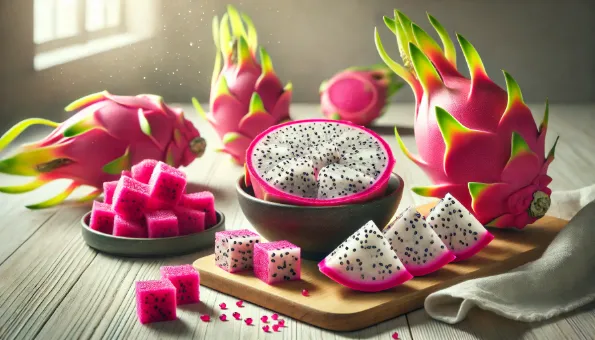Dragon Fruit (Pitaya): Hydrating & Antioxidant-Rich
A mildly sweet cactus fruit with crunchy seeds—light in calories, fiber-friendly and vibrant in bowls, salads and salsas.

What Is Dragon Fruit?
Dragon fruit (pitaya) is the fruit of climbing cacti (*Hylocereus/Selenicereus*). Varieties have **white or red flesh** with tiny edible seeds, offering a lightly sweet, refreshing taste and striking color.
Nutrition Profile
Per 100 g: **~50–60 kcal**, **~13 g carbs**, **~1–3 g fiber**, **~1 g protein**, **vitamin C (~9 mg)**, **magnesium**, and small amounts of iron. The seeds provide tiny amounts of healthy fats.
Health Benefits
- **Hydration & light energy:** High water content and modest calories.
- **Gut-friendly fiber:** Prebiotic oligosaccharides may support beneficial bacteria.
- **Antioxidants:** Red-fleshed types contain **betalains**; all varieties provide vitamin C.
- **Minerals:** Magnesium contributes to muscle and nerve function.
Possible Downsides
- **Sugar awareness:** Still a source of natural sugars—balance portions if monitoring carbs.
- **Color surprise:** Red varieties can tint urine/stool temporarily (harmless).
- **Allergy is rare** but possible—introduce gradually if sensitive.
How to Use
- Scoop and **dice for fruit salads**, smoothie bowls or yogurt.
- Make a **salsa** with lime, chili and herbs for fish or tacos.
- Blend into lemonade or iced tea for color.
- Chill well and add at the end to preserve texture.
Tip
Choose **ripe fruits** that give slightly to pressure and have bright, evenly colored skin; avoid many brown/soft spots.
- 1. Dragon Fruit
Dragon fruit / pitaya – tropski plod kaktusa (bijela ili crvena pulpa, sjemenke jestive)

